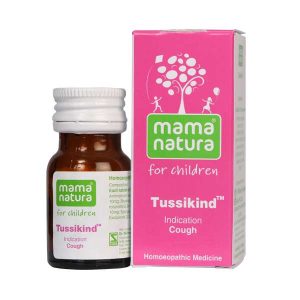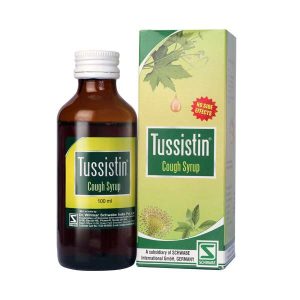
Cough in Children
-
-18%
 Rated 5.00 out of 5 based on 2 customer ratings(2)
Rated 5.00 out of 5 based on 2 customer ratings(2)₹130.00₹106.60 You Save: ₹23.40 (18%)Add to cart -
-18%
 Rated 4.50 out of 5 based on 6 customer ratings(6)
Rated 4.50 out of 5 based on 6 customer ratings(6)₹105.00₹86.10 You Save: ₹18.90 (18%)Add to cart
Showing all 2 results
Cough is a very common issue faced in childhood. Infrequently, it is a body’s reaction against a pathogen, or a foreign body lodged in the airway. Children are the common victims of this problem. It is mostly caused after a simple upper respiratory tract infection affecting the nose, throat, chest, and bronchi. The infection can be viral or bacterial. It may take a week or longer for infection to subside and cough to go away.
Acute Cough in children: The cough lasts for two weeks or less. Many children suffer from the upper respiratory tract infections, such as the common cold. They may catch the infection in preschool or daycare centers. A healthy child can have up to eight upper respiratory tract infections with a cough every year, with each lasting 10 days.
Chronic cough in children: The chough lasting for more than eight weeks. It may be caused by underlying conditions such as chronic bronchitis, asthma, an allergy – with symptoms of wheezing, chest tightness and shortness of breath.
Symptoms: Symptoms of cold and flu-like sore throat, fever, inflammation of fauces, pain in the chest, body ache are associated with cough. Wheezing may or may not be present along with cough. During cough, swelling of air passage causes constriction. It causes the production of a characteristic sound of cough ‘barking’ with raspy squeaky noises from the nose.
Common causes of cough in children:
A cough is normally a sign that the body is trying to get rid of something- an irritant, mucus in the throat, a foreign object. Common causes of cough in children include:
- An infection- A common cold or flu may lead to tarriance cough. It can be mild to moderate cough, dry or croupy. An infection causes tickling and irritation in the throat with other symptoms of a cold or flu.
- Acid reflux- cough with gagging and vomiting may just be due to acid reflux from the stomach. Sometimes a burning sensation is felt in the chest with a bad taste in the mouth. Some children may develop a hoarse voice and choke as a symptom.
- Asthma- A persistent cough at night along with other symptoms like wheezing congestion in chest dyspnea highlights asthma.
- Rhinitis/sinusitis- Sinusitis, rhinitis may produce cough as a symptom. Sometimes it is the only symptom that is noticed.
- Allergies to specific allergens like dust, pollen, smoke, perfumes can produce cough in children.
- Inhaled foreign bodies- An accidentally inhaled foreign body like small toys, rubbers or food can cause cough as a reflex to throw out the object. It is very common in young children. Parents should be very careful and keep an eye on playful children.
- Habit cough-A persistent cough after a viral infection without any clear physical cause. The cough is dry and repetitive or is a “honking” cough. It occurs only when the child is awake, not sleeping.
Why cough in children is a matter of concern for a parent?
Usually, cough causes no Harm and its a no reason for concern. But if the child is unable to stop coughing along with symptoms like nasal flaring, struggling for breath, stridor, can’t talk, drooling, anxiety, or grunts with each breath, persistent vomiting, cough up blood, pain while breathing, difficulty in speaking or choking, the fingernails and lips have turned blue, it becomes a matter of concern. You should rush your child to a doctor.
Physical examination:
- Respiratory rate, body temperature, and oxygen saturation should be noted.
- Signs of respiratory distress should be noted- Such as cyanosis, stridor, nasal flaring.
- Head and neck examination should focus on the presence and amount of nasal discharge and the condition of the nasal turbinates (pale, boggy, or inflamed). The pharynx should be checked for a postnasal drip.
- The supraclavicular and cervical lymph nodes should be palpated for lymphadenopathy.
- Lung examination- Stridor, wheezing, crackles, rhonchi, decreased breath sounds, and signs of consolidation.
- Abdominal examination- The presence of abdominal pain in the upper quadrants indicates the possibility of pneumonia in the left or right lower lobe of lungs.
- Examination of extremities- To note clubbing or cyanosis of nail beds to rule out cystic fibrosis, pulmonary disorders.
Diagnostic test:
- A routine blood examination, pulse oximetry, and chest x-ray. If foreign body aspiration is suspected, a chest x-ray with inspiratory and expiratory views are necessary. Chronic cough and a case of suspected Tb calls for a chest x-ray.
- To find out the adequacy and capability of lung inspiration and expiration effort, allergic reaction, and reaction to specific infection following tests are ordered respectively: Pulmonary function test, allergy test, nasal swab test.
- Testing is not necessary in all cases; however, if treatment has been given and there is no progress, testing may be requisite. In some cases endoscopy, bronchoscopy, a head CT may be necessary for further evaluation.
Treatment for cough in children:
TussikindTM and TussistinTM can be prescribed for different types of cough. These medicines have proved therapeutic action against bronchitis associated with viral infections. It has proved effective against cough and associated symptoms including fever. It is very mild and easy to take. It improves the general well being of the child and especially suitable for children suffering from cough or pain with a cough. It is free from narcotic effects and covers all the expectorant and antitussive properties.
Blog Post


Effects of Diabetes, Smoking, and Other Factors on Sexual Health


Plant-based Protein vs. Animal Protein: Which is Better for Your Health?





























